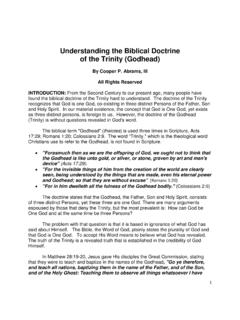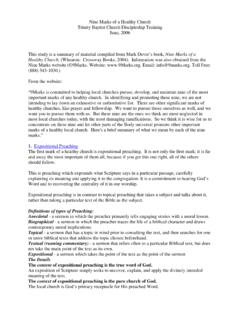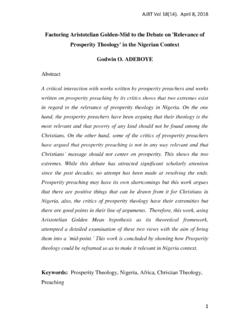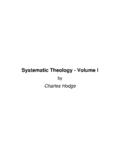Transcription of Paul and Judaism - Institute for Biblical Research
1 Bulletin for Biblical Research 3 (1993) 111-130[ 1993 Institute for Biblical Research ] paul and Judaism The Jewish Matrix of Early Christianity: Issues in the Current Debate DONALD A. HAGNER FULLER THEOLOGICAL SEMINARY 0. Fifteen years ago, E. P. Sanders published his book paul and Palestinian Judaism (Philadelphia: Fortress, 1977) and began what might well be called a Copernican revolution in Pauline One of the leading advocates of the newer knowledge has dubbed it "The New Perspective on paul ."2 The revolution, however, is not yet com- plete. Some of us, moreover, continue to believe that the evidence still points to a geocentric universe at least so far as paul 's theology is concerned.
2 In this brief paper I can hardly do justice to the subject, but I nevertheless propose to analyze the recent discussion of paul and Judaism and also at the same time to offer some critique. 1. The fundamental point of the new perspective on paul has to do not with paul himself, but with the nature of first century Juda- ism: contrary to the widespread view held even in leading reference works, Judaism was not and is not a religion where acceptance with God is earned through the merit of righteousness based on works. In the same way that Copernicus had his predecessors, this main insight of the new perspective on paul was adumbrated long before Sanders' book A paper first delivered at the annual meeting of The Institute for Biblical Re- search, San Francisco, November, 1992.
3 1. This was followed by a second important book, paul , the Law and the Jewish Peo- ple (Philadelphia: Fortress, 1983). 2. This was the title of J. D. G. Dunn's Manson Memorial Lecture given at the University of Manchester in November of 1982, published originally in BJRL 65 (1983) 95-122, and reprinted together with an "Additional Note" in Dunn's collected essays, Jesus, paul and the Law. Studies in Mark and Galatians (Louisville: Westminster/John Knox, 1990) 183-214. See now too his chapter " paul and 'Covenantal Nomism'," The Partings of the Ways Between Christianity and Judaism and their Significance for the Charac- ter of Christianity (London/Philadelphia: SCM/Trinity Press International, 1991) 117-39; and his Henton Davies Lecture, given at Regents Park College, Oxford, "The Justice of God: A Renewed Perspective on Justification by Faith," JTS 43 (1992) 1-22.
4 112 Bulletin for Biblical Research 3 (as Sanders himself readily admits). Moises Silva, in a recent article, expresses his surprise and I share that surprise at the flurry caused by Sanders' book, since its primary thrust "had been demon- strated in not a few books and was readily accessible in standard works of reference."3 Silva mentions George Foot Moore's three vol- ume Judaism in the First Centuries of the Christian Era (1927-30).4 To that we may add Moore's earlier and well-known article entitled "Christian Writers on Judaism ," where like Sanders he criticizes the work of Ferdinand Weber, as well as Sch rer and Bousset, lament- ing that legalism "for the last fifty years has become the very defini- tion and the all-sufficient condemnation of Judaism .
5 "5 Further to be mentioned is the work of such scholars as Solomon Schechter,6 R. Travers Herford,7 A. Marmorstein,8 and especially that of C. G. To my mind what explains the impact of Sanders' book is that it was the first lengthy and strongly articulated statement of the case in the post-holocaust era. Thanks to the work of many Jewish writ- ers and non-Jewish too people have become sensitized concern- ing the role of anti- Judaism in nourishing the evil of anti-Semitism. It was a point whose time had come. 2. A second and nearly as important point in the new perspec- tive on paul is again one that had been made much earlier: contrary to the Reformation understanding of paul , justification by faith is not the center of paul 's theology but instead represents a pragmatic tactic to fa- cilitate the Gentile mission.
6 It will be easily seen how well this works together with the preceding point. If Judaism is not a religion of works-righteousness, then it hardly needs to hear the message of justification by faith, whereas that message makes perfect sense if directed solely to the Gentiles. 3. "The Law and Christianity: Dunn's New Synthesis," WTJ 53 (1991) 339-53, here 348. 4. The book bears the subtitle "The Age of the Tannaim" and was published in Cambridge, MA, by Harvard University Press. Silva calls attention to the following passages: 1:110-21, 520-45. 5. HTR 14 (1921) 197-254, here 252. 6. Aspects of Rabbinic Theology (Macmillan, 1909; reprinted New York: Schocken, 1961).
7 7. See especially Judaism in the New Testament Period (London: Lindsey, 1928); "The Fundamentals of Religion as Interpreted by Christianity and Rabbinic Judaism ," HJ 21 (1922-23) 314-26. 8. The Doctrine of Merits in Old Rabbinical Literature (1920; reprint New York: KTAV, 1968). 9. See, , "On Some Misconceptions of Judaism and Christianity by Each Other," JQR 8 (1896) 193-216; "Jewish Scholarship and Christian Silence," HJ 1 (1902- 3) 335-46; Rabbinic Literature and Gospel Teaching (1930; reprint New York: KTAV, 1970). HAGNER: paul and Judaism 113 Although this point is not very important in Sanders' book, he does review the arguments of Albert Schweitzer concerning the rel- atively small importance of justification by faith in paul 's theology, concluding that "they have never been effectively countered.
8 "10 Schweitzer put his conclusion in a typically vivid metaphor: "The doctrine of righteousness by faith is therefore a subsidiary crater, which has formed within the rim of the main crater the mystical doctrine of redemption through the being-in-Christ."11 The conclu- sion concerning the subordinate importance of the doctrine was not even original with Schweitzer, having already been argued at least as early as 1853 by Lipsius, and also Sabatier, L demann, Weiz- sacker and The new perspective on paul has given new life to this 3. These two main foundations of the new perspective on paul thus raise again two fundamental questions: What was the nature of first century Judaism ? and What is at the heart of paul 's Chris- tianity?
9 Or, to put it differently, What was the difference between Saul the Pharisee and paul the Christian? The answers to these inter- related questions have produced a number of corollary conclusions, and to these we now turn. The new perspective on paul maintains that paul 's theology has been misunderstood because it has been read through the lens of Luther and the Reformation. Luther's rediscovery of the gospel was preceded by an agonizing personal struggle with the problem of sin and of at- tempted self-justification. Such was not the case with paul , as Phil 3:6, referring to paul 's background as a Pharisee, indicates: "As to righteousness under the law," he writes, "I was blameless." Since Ju- daism was not a religion of works-righteousness, paul did not have to move from legalism to grace, as in the typical protestant schema.
10 Proponents of the new perspective on paul have made much of K. Stendahl's 1963 article, "The Apostle paul and the Introspective Conscience of the West."14 It was indeed a pathbreaking article in some ways, anticipating much of the new perspective, yet even its main point had been articulated much earlier. T. W. Manson 10. paul and Palestinian Judaism , 440. 11. The Mysticism of paul the Apostle (trans. W. Montgomery from 1930 original; New York: Seabury, 1931) 225. 12. See the informative article by R. Fung, "The Status of Justification by Faith in paul 's Thought: a Brief Survey of a Modern Debate," Themelios 6 (1981) 4-11. See too the Appendix in Sanders' paul and Palestinian Judaism by M.








